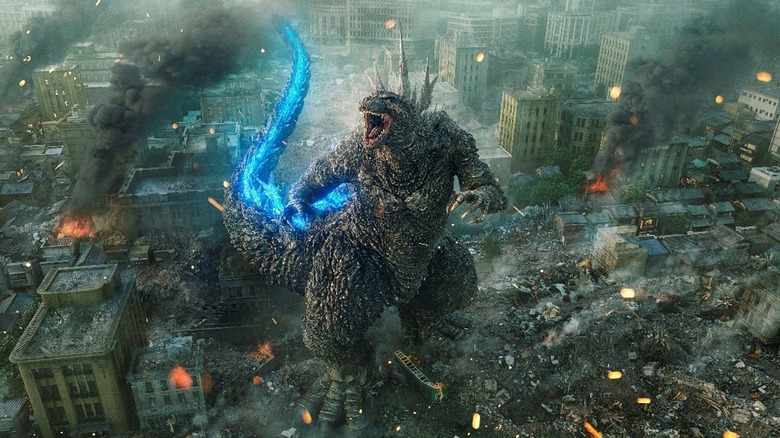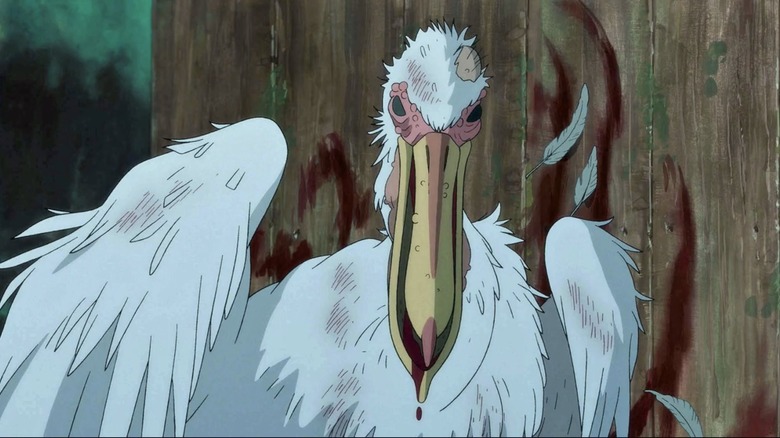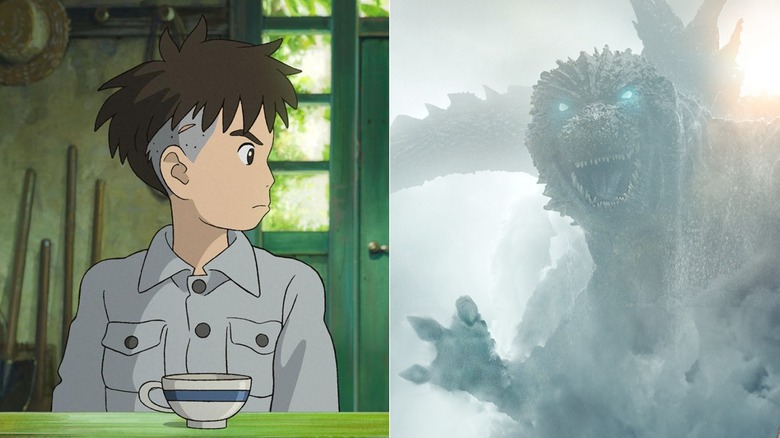Godzilla And Miyazaki Prove There's An Appetite For Japanese Movies At The Box Office
It had been a quiet couple of weeks at the box office until "Wonka" arrived to liven things up with a bigger-than-expected debut. Luckily, "The Hunger Games: The Ballad of Songbirds and Snakes" has had long legs, or theaters would truly be in rough shape, as Disney's "Wish" flopped pretty hard and "Renaissance: A Film by Beyonce" didn't hold nearly as well as "Taylor Swift: The Eras Tour" did. Thankfully, a pair of imports from Japan emerged as unexpected saviors.
Toho's "Godzilla Minus One" and Studio Ghibli's "The Boy and the Heron" have both overperformed at the box office in North America in recent weeks. Director Takashi Yamazaki's wildly acclaimed new take on the King of the Monsters has remained in the top five for three weekends now, and even topped the U.S. charts for several days. Toho has since extended the film's run well beyond what was originally intended, adding more screens along the way. It has now amassed $35 million domestically with a potentially lucrative Christmas frame coming up.
Meanwhile, Hayao Miyazaki's "Heron," marking his first feature film in a decade, became a straight-up event and surprised the industry by topping the box office on its opening weekend. It was the first time in history that an original anime took the number one spot. Miyazaki, the director of classics such as "Spirited Away" and "Ponyo," has become an almost mythical filmmaker at this point, and audiences proved that in a big way. Through two weekends and change, the film has made almost $25 million domestically.
It wasn't just one weekend and done — moviegoers are continuing to show up. Granted, we're talking about well-established brands but there are notable differences. For further context, 2016's also acclaimed "Shin Godzilla" earned just shy of $2 million during its entire domestic run. The tide is turning.
Serving under-served audiences
These are both films that were minimally advertised (compared with big U.S. releases anyhow) and yet, they managed to break through the noise. "Godzilla Minus One" was without a doubt driven almost entirely by rapturous word of mouth. It became a bonafide "you need to see this" movie that audiences talked about in real life, which is the kind of thing that can't be manufactured. It's also part of a much larger moment that Godzilla is having right now, coupled with the forthcoming "Godzilla x Kong: The New Empire" and Apple's "Monarch: Legacy of Monsters."
As for "The Boy and the Heron," it similarly managed to motivate Miyazaki loyalists to show up in theaters rather than wait for it to arrive on a streaming service and/or Blu-ray. It became a "leave the house" worthy event, which is much harder to come by in the pandemic era. The success has been driven in large part by a stellar reception (read our review here), but also aided by the fact that audiences can see in its original Japanese language version or a dubbed version with an A-list voice cast.
However it came to be, we're looking at two movies that have collectively added roughly $60 million and counting to the domestic box office in recent weeks. Theaters sorely needed this money after a very rough month in November that saw several high-profile flops like "The Marvels" eat into expected ticket sales. Japan came to the rescue and, in the process, demonstrated that American audiences are very much ready to embrace Japanese cinema in a meaningful way. This could have positive implications in the future for both moviegoers and theater owners, assuming this potential is embraced going forward. There is an audience here and, if served properly, they will turn out.
A path forward for the domestic box office
The other key thing to point out is that these movies can make the money they're making on fewer screens. "Minus One" is currently available on 2,600 screens and pulled in $5 million in its most recent weekend. "Wonka" opened on 4,200 screens. This is important because it means these Japanese imports can still pull a respectable per-screen average, which is what theaters truly need. It doesn't help if a movie is taking up screens that aren't selling tickets.
This also isn't the first hint we've had that Japanese cinema can be lucrative in North America. Anime films such as "Demon Slayer: Kimetsu no Yaiba – The Movie: Mugen Train," "Jujutsu Kaisen 0," and "Dragon Ball Super: Super Hero," among others, have similarly filled theaters in recent years. With relative consistency, these imports have been putting meat in seats. The audiences are loyal, and that makes it reliable money.
Now, can $60 million from two relatively niche releases make up for a lack of a Hollywood blockbuster? Not necessarily. But to use a sports metaphor, in football, a field goal gets points on the board. It may not be a touchdown, but you'll take the points. Enough field goals and you can still win the game. Points are points, money is money.
The larger point is this: As the industry looks for a path forward to get the box office back to pre-pandemic levels, this could be a key piece of the puzzle. Bring Japanese films to U.S. audiences with more frequency and it could help fill the void. And, with further optimism in place, this could open the door for imports from other countries as well. The risk is minimal for distributors but the potential rewards are sizable.
"Godzilla Minus One" and "The Boy and the Heron" are in theaters now.


